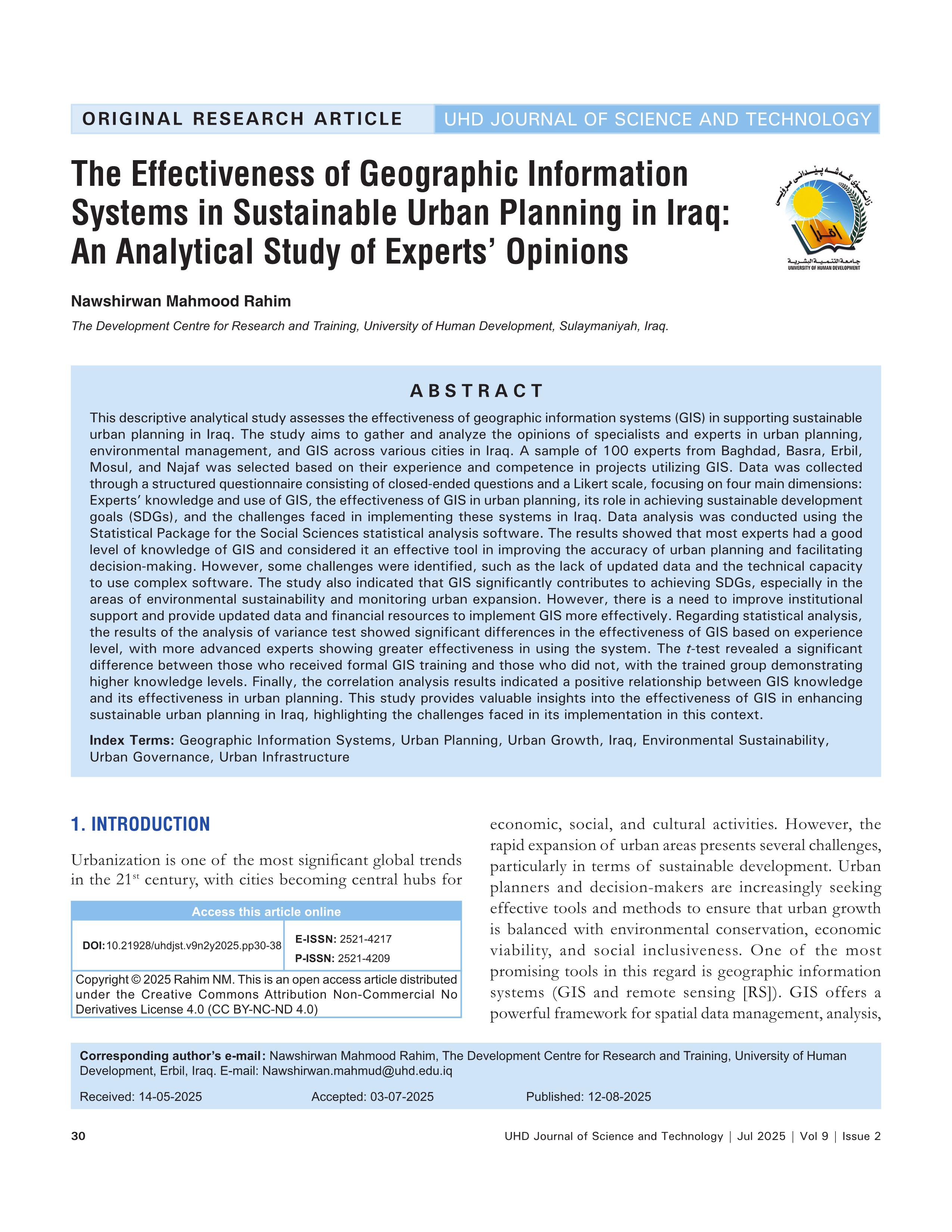The Effectiveness of Geographic Information Systems in Sustainable Urban Planning in Iraq: An Analytical Study of Experts’ Opinions
DOI:
https://doi.org/10.21928/uhdjst.v9n2y2025.pp30-38Keywords:
Geographic Information Systems, Urban Planning, Urban Growth, Iraq, Environmental Sustainability, Urban Governance, Urban InfrastructureAbstract
This descriptive analytical study assesses the effectiveness of geographic information systems (GIS) in supporting sustainable urban planning in Iraq. The study aims to gather and analyze the opinions of specialists and experts in urban planning, environmental management, and GIS across various cities in Iraq. A sample of 100 experts from Baghdad, Basra, Erbil, Mosul, and Najaf was selected based on their experience and competence in projects utilizing GIS. Data was collected through a structured questionnaire consisting of closed-ended questions and a Likert scale, focusing on four main dimensions: Experts’ knowledge and use of GIS, the effectiveness of GIS in urban planning, its role in achieving sustainable development goals (SDGs), and the challenges faced in implementing these systems in Iraq. Data analysis was conducted using the Statistical Package for the Social Sciences statistical analysis software. The results showed that most experts had a good level of knowledge of GIS and considered it an effective tool in improving the accuracy of urban planning and facilitating decision-making. However, some challenges were identified, such as the lack of updated data and the technical capacity to use complex software. The study also indicated that GIS significantly contributes to achieving SDGs, especially in the areas of environmental sustainability and monitoring urban expansion. However, there is a need to improve institutional support and provide updated data and financial resources to implement GIS more effectively. Regarding statistical analysis, the results of the analysis of variance test showed significant differences in the effectiveness of GIS based on experience level, with more advanced experts showing greater effectiveness in using the system. The t-test revealed a significant difference between those who received formal GIS training and those who did not, with the trained group demonstrating higher knowledge levels. Finally, the correlation analysis results indicated a positive relationship between GIS knowledge and its effectiveness in urban planning. This study provides valuable insights into the effectiveness of GIS in enhancing sustainable urban planning in Iraq, highlighting the challenges faced in its implementation in this context.
References
E. W. Manning. “Geographic information systems and sustainable development”. Government Information Quarterly, vol. 7, no. 3, pp. 329-342, 1990.
P. A. Longley. “Geographical information systems: Will developments in urban remote sensing and GIS lead to ‘better’urban geography?the” Progress in Human Geography, vol. 26, no. 2, pp. 231–239., 2002.
R. Sultani, A. Soliman and K. Al-Hagla. “The use of geographic information system (GIS) based spatial decision support system (SDSS) in developing the urban planning process”. Architecture and Planning Journal, vol. 20, pp. 97-115, 2009.
M. P. Lewis and A. Ogra. “An approach of geographic information system (GIS) for good urban governance”. In: 2010 18th International Conference on Geoinformatics. IEEE, United States, p. 1-6, 2010.
V. Maliene, V. Grigonis, V. Palevičius and S. Griffiths. “Geographic information system: Old principles with new capabilities”. Urban Design International, vol. 16, pp. 1-6, 2011 .
Z. Gharineiat and M. Khalfan. “Using the geographic information system (GIS) in the sustainable transportation”. International Journal of Social, Behavioral, Educational, Economic, Business and Industrial Engineering, vol. 5, pp. 1425–1431, 2011.
A. Khaleel and A. K. Bety. “Urban Geomorphology of Sulaimani City, Using Remote Sensing and GIS Techniques, Kurdistan Region, Iraq, [Thesis]”. 2013.
E. Walsund. “Geographical Information Systems as a Tool in Sustainable Urban Development”. Malmö University Publications, Malmö, 2013.
S. Xhafa and A. Kosovrasti. “Geographic information systems (GIS) in urban planning”. European Journal of Interdisciplinary Studies, vol. 1, no. 1, pp. 74-81, 2015.
M. H. Zuidgeest, M. J. Brussel and M. F. Van Maarseveen. “GIS for sustainable urban transport”. ISPRS International Journal of Geo- Information, vol. 4, no. 4, p. 2583-2585, 2015.
N. Cabrera-Jara, D. Orellana and M. A. Hermida. “Assessing sustainable urban densification using geographic information systems”. International Journal of Sustainable Building Technology and Urban Development, vol. 8, pp. 237–243., 2017.
K. Kurowska, R. Marks-Bielska, S. Bielski, A. Aleknavičius and C. Kowalczyk. “Geographic information systems and the sustainable development of rural areas”. Land, vol. 10, no. 1, p. 6, 2020.
H. Ouchra, A. Belangour and A. Erraissi. “A comprehensive study of using remote sensing and geographical information systems for urban planning”. Internetworking Indonesia Journal, vol. 14, no. 1, pp. 15-20, 2022.
N. H. K. Linh, P. G. Tung, H. V. Chuong, N. B. Ngoc and T. T. Phuong. “The application of geographical information systems and the analytic hierarchy process in selecting sustainable areas for urban green spaces: A case study in Hue City, Vietnam”. Climate, vol. 10, no. 6, p. 82, 2022.
J. Younis and C. I. Ahmed. “Application of remote sensing and GIS to mapping groundwater potential zones of Khazir River Basin, Northern Iraq”. Iraqi National Journal of Earth Science, vol. 22, no. 2, pp. 209-230, 2022.
M. Alsalmany, R. Thannoun and A. Shehab. “Determining the impact of climatic elements on vegetation cover based on remote sensing data - (Al-Hamdaniya district as a case study)”. Iraqi National Journal of Earth Science, vol. 23, no. 1, pp. 13-25, 2023.
L. An, G. Liu and M. Hou. “The application of geographic information system in urban forest ecological compensation and sustainable development evaluation”. Forests, vol. 15, no. 2, p. 285, 2024 .
S. Elias Al-Janqli and O. Ismaeel. “Spatial modeling of groundwater potential existence using GIS: Nineveh governorate as a model”. Iraqi National Journal of Earth Science, vol. 25, no. 2, pp. 38-56, 2025.

Downloads
Published
How to Cite
Issue
Section
License
Copyright (c) 2025 Nawshirwan Mahmood Rahim

This work is licensed under a Creative Commons Attribution-NonCommercial-NoDerivatives 4.0 International License.


